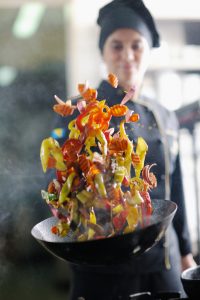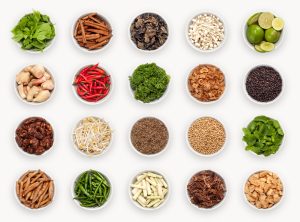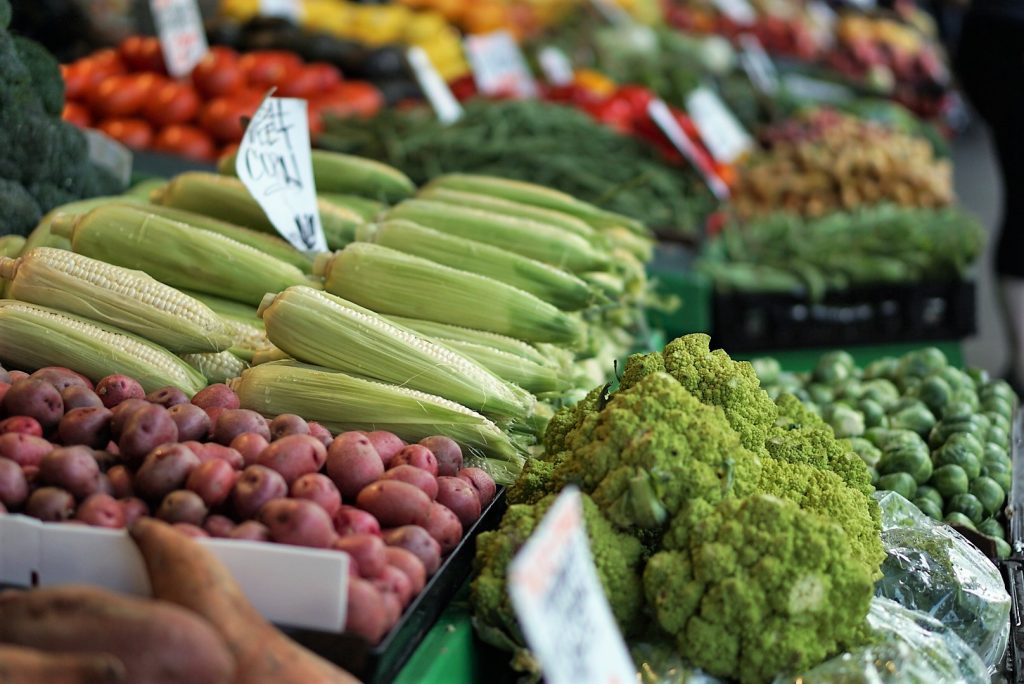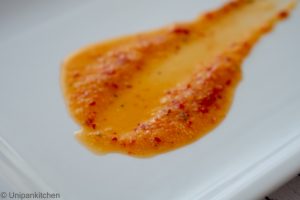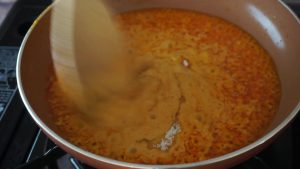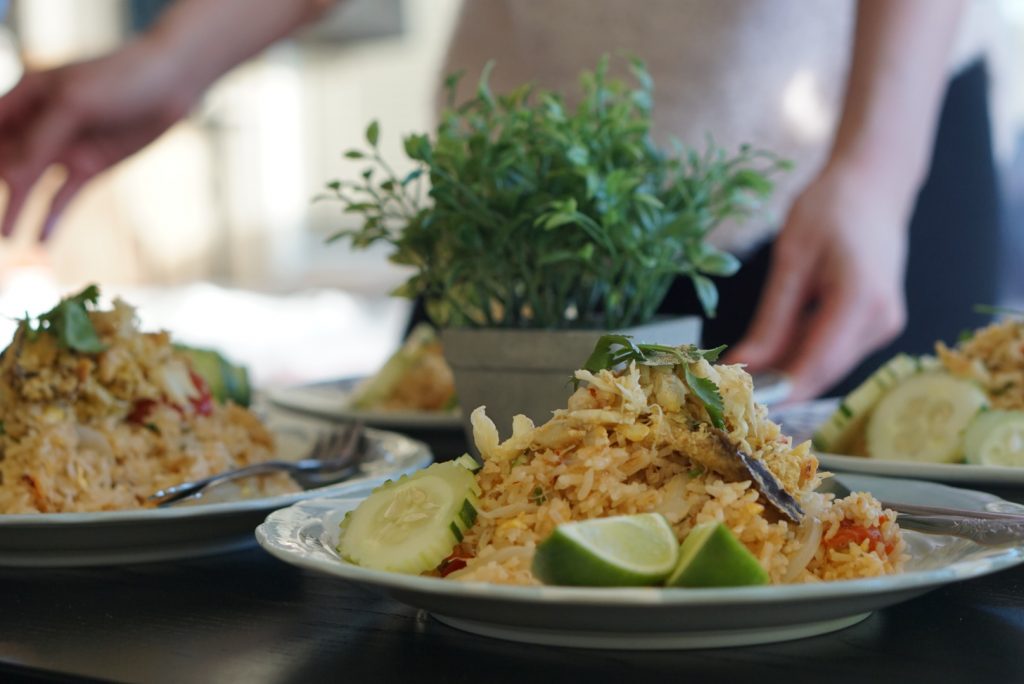Why cooking Thai Food?
If you like cooking instead of buying food from restaurants because you know that cooking it yourself has more benefits and controllable, I recommend you to start cooking Thai food today because:
- Thai food is naturally healthy.
- Cooking is incredibly easy once you’ve learned it.
- We use a variety of herbs and spices, choice of meats,
- a vegetable selection so that you can mix and match or even create your fusion meal.
- You are now following the trend! According to the direction in 2018 form restaurant association, Chefs aim to create local traditional dish combined with global flavors.
Here we are. Try to explore and stay tuned on our site, I promise I will walk along with you for a healthier lifestyle.
You don’t need to be an Iron Chef to master Thai cooking even though it has a complexity of flavors.
To begin with, I accumulate 3 steps you should know, so your mindset will be ready to share Thai cooking in your kitchen.
1. Knowing about herbs and spices
95% of traditional Thai food contains countless types of herbs and spices, for example, lemongrass kiffir lime leaf galangal root, ginger, cumin, coriander, peppers, etc
Don’t be overwhelmed! It’ok you don’t have to study all these!
Using herbs and spices is making your dish hot and unique, so get familiar with the ones you like and avoid some that you don’t feel like it.
I don’t like cinnamon, so I skip or minimal it every time the recipe says.
I will gather some of the herbs and spices that I use frequently and their benefits.
Fresh herbs and spices
- 3-knight herbs: lemongrass, Kaffir lime leaves, galangal root. I call this because they are my warriors which I use widely to enhance my soups and salads. They all have a lot of benefits such as wind, reduce cholesterol, reduce blood sugar pressure, expectorating, heartburns, reduce inflammation, slow down the growth of cancer cells, etc.
Lemongrass stalks give citrus fruity flavor closed to lemon. The inner layers can be chopped and eat.
Kaffir lime leaves have a thick piece which not easy to chew. They give an intense lime flavor and a hint of heat. I usually shred or tear the leaves to extract the smell thoroughly.
Galanga or galangal root has a flavor closed to ginger root. It gives spicy flavor but not make your food hot spicy at all (weird!)
- Ginger is from China. It has a definite spice to it. It helps alleviate nausea.
- Fingerroot is used in curry noodle paste. Not widely but it helps you on “number two”(in a good way)
- Fresh peppercorns are always used in a stir-fry dish or some curries.
- Fresh garlic is widely used in most Thai dishes and Asians. It helps you to reduce cholesterol level.
- Fresh bird’s eye chili peppers or cayenne pepper has an extremely hot and spicy flavor. This will helps you from losing appetites and enables you to wind.
- Thai sweet basil and Holy basil are edible herbs that you can use in Pad Grapow but don’t be confused with these two. Thai Sweet basil or hor-rah-pah has a slightly sweet taste while Thai holy basil(Bai-gra-pow) has a stronger smell and spicier.
- Spearmint is commonly used in North of Thailand and widely used in Thai salads
- Coriander/cilantro leaves are also common herbs we use for garnishing and adding extra umami flavor
- Coriander root has an extreme smell when used for marinating or soup. Sometimes, we use to make curry paste
Sometimes use:
- Cumin is used to make curry paste. It’s hard to find fresh even in Thailand, so you usually can find dried cumin at any Asian store worldwide now.
- Turmeric gives yellow to a dish–Yellow curry for instance. It helps to reduce inflammation
Dried herbs and spices
- Sesame seeds help to decrease in both systolic and diastolic blood pressure. I mostly use them in Japanese and Korean cuisines
- Cinnamon has many benefits as I link here Healthline . I don’t like it, but I always add it in Palo(Braised pork hog in five-spice soup).
- Star aniseeds are medical-smell-like spices. I add them on Palo as well
- Coriander seeds are the spice I love. They have a cooling flavor, and I use it to marinate meats for grilling and frying.
- Curry powder is from the Indian subcontinent. It consists of coriander, turmeric, cumin, fenugreek, and chili peppers. You can buy it widely in the grocery store now.
- Five-spice powder is a Chinese ultimate soup base. I use it in fatty-meat soup such as Palo and braised beef stew.
- Dried chilies are used for heat up my dish, and I use them a lot.
- Black Pepper and white pepper also slightly heat up all type of cooking. The benefit is enormous.
2. Practicing the art of balancing flavors
Have you ever created art of painting?
There are only 3 primary colors, blue, red, and green, and also black and white which you can make a colorful masterpiece. And if you have made one, you just created a visual art which you can appreciate it with your eyes.
Cooking is like a painting.
But, you will appreciate it with your tongue and nose.
There are 5 main tastes in the world: salty, sweet, sour, bitter and savory.
Savoriness or umami is like a white canvas on which you can merely paint any colors on it. And, savory taste naturally comes from meats, seafood, some vegetables, herbs, and spices.
Then you can paint with saltiness, sourness, sweetness, and bitterness, and there’s no right or wrong on how you’re going to balance them.
I start adding salty and sweet first because they have a deep feeling–as you can enjoy it alone; salt or sugar–but you can’t eat pure vinegar or chew a bitter melon alone.
Bitterness is mostly from herbs and vegetables, so make sure you don’t overuse it. Adding too much bitterness can ruin your taste and flavor, but you have to have it in a particular dish.
Most of Thai food has sweetness and saltiness balancing, for instance, red curry has outstanding saltiness and light on sweetness, no sourness at all.
Link: Choo Chee Red Curry with Salmon and Scallops
For some dishes have 3 flavors balancing in them, and that’s why Thai food is hard to manage sometimes. I have to be patient with this kind of food, plan out and be sober.
Link: How I make Tom Zap Pork Ribs with 3 flavors
You might get confused is spicy is not a taste. It is only a term of chemical reactions to your tongue, throat, and the stomach.
3. Learning the most-used Thai cooking methods
Thai cooking methods are not much different from other cuisine practices. Otherwise, they are homely and uncomplicating at all once you get used to it.
There’re only 11 main cooking methods I gather from my experience from Thai restaurant industry over 10 years and some of these are a common process like boiling, grilling, stir-frying, deep frying, baking and steaming.
However, there are some authentic cooking methods I like to introduce you to start learning Thai food: Yum(Salad mixing), Tum(pounding, Salad smashing), and Kaeng(making curry)
Download the free ebook: Thai Cooking 101: A Guide To 11 Methods Of Home-Cooking | How To Cook Thai Food When You Have No Clue
In Unipan Kitchen’s blog, I organize the recipes into a category of cooking methods so you can navigate quickly and feel free to leave some comments. Some of the recipes might be processed more than one method, so I’ve listed in all categories I’ve used.
And learn by getting real cooking is the fastest way to enjoy real food.
4(bonus). Understanding how Thai people eat and cook
Cooking Thai food is one of the family activities which means you can have fun with it.
When I start cooking, I will call my friends, mom in law, neighbors to give me a hand and help me taste it.
With this bullet points of authentic Thai culture, you can adapt to fit your etiquette style, and you will enjoy the meal like Thais do 🙂
We share food at dinner, and we always pick the various type of dishes and different spicy levels.
Like many cultures, a family gets together to eat and share food, Thai people spend the spare time before bed cooking and eating together.
The chef should know how spicy each member can handle, so you can adjust the recipe according to what they prefer.
When I was in Thailand, my mom was the chef in our family, and I was her assistant. We had 4-5 children (including me!), 4 adults and 2 elders, so she had to make 3 different spicy levels: not spicy, mild, and extremely spicy.
Also, she cooked a variety of dishes:
- stir-fried morning glory
- pineapple curry with mussels
- Tom Yum soup with chicken wings
- shrimp paste chili sauce, and some fresh vegetables.
For the same reason, choose your dishes wisely when making a shared meal because Thai food is vibrant and complex in flavor.
I even mix with other cuisines in my dinner sometimes.
Thai traditional etiquette is to eat rice as a main dish, food as side dishes, so we use a spoon to scoop everything and a fork as guiding into one bite
Thailand is the land of rice. Half of every bite is usually steamed rice. That’s why most Thai food is spicy. We reduce the spiciness by adding more rice.
To eat Thai curry, we ladle the curry on the top of rice, mix it up, and scoop up to eat. So, you can control how much spicy sauce should blend in with rice, only add more rice when it comes too hot.
Therefore, if you’re tasting your food and it’s still bland, don’t be afraid to add more of everything to make it outstanding because you will need to eat with lots of rice anyway.
Let’s make your Thai food alive!
- If it’s supposed to be salty, add more salt, soy sauce or fish sauce and make it saltier.
- Is it should be sweet (not a dessert)? Go ahead add more sugar.
- Does your recipe say the sourness is prominent? Don’t be scared of adding more lime juice, vinegar, or tamarind sauce.
- Smell it. If it doesn’t make aroma or spicy enough, add more herbs, spices, or chili.
- If you’ve tried all these and there’s something wrong, think about savory taste you have created from the beginning.
We always have spicy trays, condiments and sauces ready all the time. For example, prik num pla, seafood dipping sauce, chili flakes, chili oil paste, vinegar, and pepper, etc
When you visit any Thai restaurants near you, they surely have spicy trays to add spicier to your plate.
However, restaurants in Thailand set not only spices, but they have a whole seasoning tray for you such as sugar, fish sauce, vinegar, lime wedges, etc.
Why don’t they season well in the first place!
The answer is “I don’t know!”, it might be we want to craft our food every time even when mom cooks it.
And, that’s how Thai people eat it!
In conclusion,
It’s easy to start cooking Thai food right the way. Since you’ve downloaded a recipe in hand and got the grocery list checked out, then you came back to the kitchen and started the first direction.
Your food may turn out so tasty and mouth-watery. Congratulations!
But, if it’s not what you expected, we want to help you learn how to cook and eat real Thai food from authentic to modern by starting these 3+1 steps: knowing the herbs and spices, practicing the balancing flavors, learning the most-used Thai cooking methods and understanding Thai food culture.
Plus, learn more about cooking and try the recipes in our blog until you can create and develop by yourself and be a master chef around the neighborhood.
Save your money you spend on takeouts and save your valuable time with your family at home cooking delicious Thai food.
Happy cooking 😉


